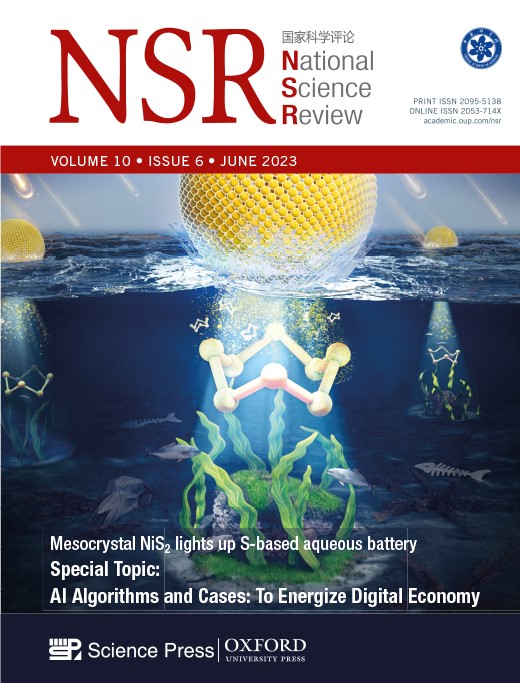将手性冠醚构建成用于电色谱对映体分离的坚固共价有机框架
IF 16.3
1区 综合性期刊
Q1 MULTIDISCIPLINARY SCIENCES
引用次数: 0
摘要
毛细管电色谱(CEC)是一种迅速崛起的分离技术,它融合了毛细管电泳的高分离效率和液相色谱的卓越选择性。然而,在 CEC 对映体分离过程中,如何设计出对酸碱具有高度化学稳定性的功能性手性固定相(CSP)仍然是一项合成挑战。在这里,我们证明了将手性冠醚加入稳定的共价有机框架(COFs)可通过 CEC 高效、稳定地分离外消旋体。这有助于我们通过缩聚手性 1,1'-联萘-20-冠醚-6 衍生的二醛和具有二异丙基取代基的四胺来制作两种三维手性 COF(CCOF)。这两种化合物都具有 11 层互穿透金刚石框架,其特点是管状开放通道上装饰有作为对映选择性识别和结合位点的手性冠醚。这些框架在水、酸和碱中都表现出了极佳的稳定性,这要归功于它们含有能保护动态亚胺连接的大块异丙基。此外,精确定义的 COF 通道增强了封闭的冠醚对分析物的可及性,同时提供了对恶劣环境的有力保护,使它们适用于 CEC 分离中的 CSP。将它们用作手性色谱柱的涂层,可以有效分离一些重要的对映体,包括酮类、环氧化物和碱性物质,尤其有利于药物的手性分离。这项研究推动了 COFs 在电色谱分离中的应用,扩大了多孔材料设计和工程学的范围,从而创造出具有目标对映选择特性的 COFs。本文章由计算机程序翻译,如有差异,请以英文原文为准。
Construction of chiral crown ethers into robust covalent organic frameworks for electrochromatographic enantioseparation
Capillary electrochromatography (CEC) is a rapidly emerging separation technique that merges the high separation efficiency of capillary electrophoresis with the exceptional selectivity of liquid chromatography. However, it remains a synthetic challenge to design functional chiral stationary phases (CSPs) with high chemical stability against acid and base in CEC enantioseparation. Here we demonstrate that incorporating chiral crown ethers into stable covalent organic frameworks (COFs) enable efficient and stable separations of racemates by CEC. This facilitates us to craft two three-dimensional chiral COFs (CCOFs) by polycondensation of a chiral 1,1'-binaphyl-20-crown-6-derived dialdehyde and tetraamines with diisopropyl substituents. Both feature a 11-fold interpenetrated diamond framework, characterized by tubular open channels decorated with chiral crown ethers serving as enantioselective recognition and binding sites. These frameworks demonstrate excellent stability in water, acid, and base, thanks to the presence of bulky iso-propyl groups that shield the dynamic imine linkages. Moreover, the precisely defined COF channels enhanced the accessibility of the enclosed crown ethers to the analytes while providing strong protection against harsh environments, rendering them suitable for CSPs in CEC separations. They can effectively separate some important enantiomers, including ketones, epoxides, and alkaline substances, when utilized as coatings on chiral columns, particularly facilitating the chiral separation of drugs. This study advances the application of COFs in electrochromatographic separations, expanding the scope of porous materials design and engineering to create COFs with targeted enantioselective properties.
求助全文
通过发布文献求助,成功后即可免费获取论文全文。
去求助
来源期刊

National Science Review
MULTIDISCIPLINARY SCIENCES-
CiteScore
24.10
自引率
1.90%
发文量
249
审稿时长
13 weeks
期刊介绍:
National Science Review (NSR; ISSN abbreviation: Natl. Sci. Rev.) is an English-language peer-reviewed multidisciplinary open-access scientific journal published by Oxford University Press under the auspices of the Chinese Academy of Sciences.According to Journal Citation Reports, its 2021 impact factor was 23.178.
National Science Review publishes both review articles and perspectives as well as original research in the form of brief communications and research articles.
 求助内容:
求助内容: 应助结果提醒方式:
应助结果提醒方式:


